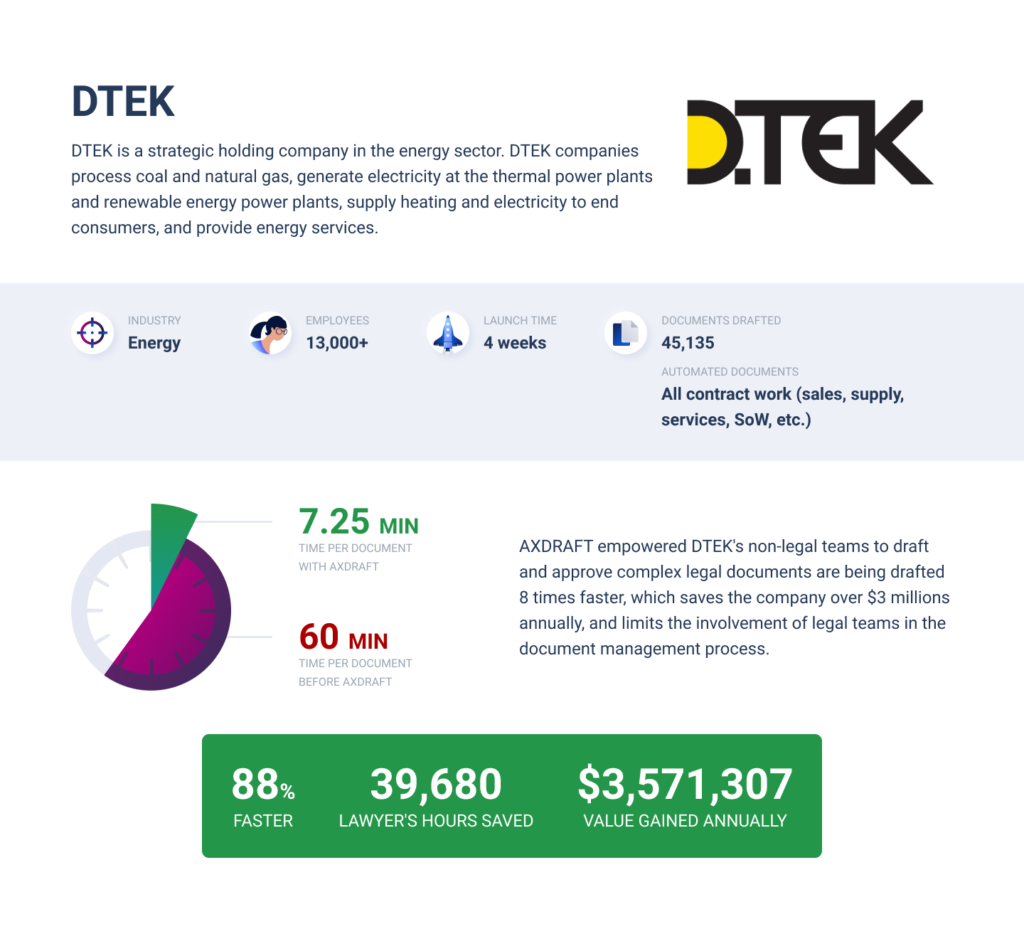When you’re processing tens of thousands of contracts a month — some big, some important, and others just routine — it can prove to be a real challenge. It’s especially difficult for corporations that contain many different companies within their structure. The number of departments and systems can break into the low hundreds! On top of that, there are tons of contracts.
And yet somehow, everything needs to be connected.
In such situations, it almost seems impossible to control legal operations. Fortunately, modern contract lifecycle management solutions can help you stay on top of processes, no matter how many documents you need to handle.
Contracting Challenges Big Companies Face
Here are some contract management challenges that can easily be eliminated with automation.
If you don’t control your workflows, you risk suffering financial and reputational losses. That’s why big companies are usually “slow” to change. They need to check that everything is legally in order. Slow processes, even when perfectly done, may obstruct a company’s growth and profits.
Hunting down contracts
One of the biggest challenges companies face is manually hunting down contracts in excel spreadsheets or word documents across different systems and folders. When contracts are stored like this, you can never be sure where any given contract is. And it’s difficult to even predict how long it will take to find and check the information.
For a better understanding, here are some real numbers: DTEK (an AXDRAFT client) creates 50,000 contracts each year. DTEK has almost 50 other companies under its umbrella, making it one of the biggest suppliers of heating and electricity for consumers. If a document goes missing, somebody could be left without heat or electricity.
How AXDRAFT deals with it
AXDRAFT provides centralized storage for DTEK where all contracts (old and new) are stored.
When a user needs to find a contract, it doesn’t matter which company created it. Thanks to smart search and metadata, any document can be located among hundreds of thousands in a few clicks. You can set the filter and enter a date, name, contract type, or some other criterion. You can add tags to documents or search them by text.
Lack of visibility
There are a lot of things you may need information about: dates, terms, costs, addendums, deliverables, counterparty data, and due diligence. For big companies that manage a huge amount of such information, it’s quite easy to lose track of critical data without a proper contract management system.
Insufficient visibility also leaves no room for analytics and informed business decisions since you can’t evaluate a specific team or contract, let alone the entire organization. This may prevent you from adjusting your strategy to suit your business needs.
How AXDRAFT deals with it
CLM systems cover the entire contract lifecycle while providing more visibility into contracts. For DTEK, AXDRAFT integrated with their databases, bringing all processes under one roof.
All information about bank details, signatories, key dates, and responsible parties became easily accessible. As for due dates, they don’t even have to check them. They just need to set a reminder. When the time comes, AXDRAFT sends a notification via email and inside the app.
Database integration also allows collecting data for tailored reports that evaluate the corporation’s overall performance, as well as that of a specific company or team.

Wrong templates
With many companies inside the corporate structure, it’s essential to use only up-to-date templates. One mistake may lead to compliance breaches or security issues. If you sign the wrong contract, restarting the process and replacing it with a new agreement takes time. And it certainly won’t help your reputation.
How AXDRAFT deals with it
Version control is a must-have feature for any contract lifecycle management solution. But for big enterprises, more is needed. For example, AXDRAFT is fully integrated with DTEK’s document management system.
This helps keep all documents under control. Users can’t send documents created outside AXDRAFT for approval. Also, templates can’t be edited at will, which ensures that only changes allowed by the system are made.
Convoluted approvals
Before signing, a contract must be reviewed and approved by certain people. With multiple companies in a group, each one might have its own unique approval process with its own approvers. If there are different systems across many companies, you need to identify how to find people, exchange requests between different offices, get the necessary reviewers to approve the document, and double-check that you haven’t missed somebody.

How AXDRAFT deals with it
Automation can simplify approval flows in organizations of any size. Integrations with databases, like the one we did for DTEK, allow the system to assign approvers automatically, according to predefined requirements.
The system knows the authorized signatories of each company and for which scenarios. For example, if a document contains some parts that should be approved by a financial director, or somebody from HQ, the required person will be assigned automatically.
They will receive a notification that a contract needs their attention, and you’ll receive a notification once it’s approved or needs some changes. You can also assign them to review only specific clauses so that they don’t have to check the whole agreement. This renders one of the most time-consuming stages of a contract’s life quick and simple.
Missing audit trail
An audit trail includes all project and financial details, changes, and adjustments for the document. It’s important to be able to track the entire history of your relationships with partners as it provides information about the who, when, why, and what of changes made to a contract. Knowing this will help you fulfill your obligations correctly and on time, as well as protect your interests in case some misunderstandings with a counterparty occur.
How AXDRAFT deals with it
Integrating with the company’s databases allows AXDRAFT not only to assign an approval flow, but also to record who made changes, when, and what was changed.
To make information even more structured, there are “Projects” in AXDRAFT.
In simple words, a project is a folder dedicated to a specific client. Such folders store all the data you saved when creating a document. It always remains at your fingertips, and you can easily audit the whole history of your dealings with a particular counterparty.
You can also attach additional documents, such as invoices or powers of attorney, to the relevant contract so that all important information is kept close at hand.
Uncertainty about contract contents
There may be two main reasons for such a situation:
- Different business units may have different templates for one document. If this happens, nobody can tell for sure what’s stated in a particular contract.
- People can convey the same idea in various ways. In the same manner, contracts of one type can interpret the same information differently. If non-legal units don’t understand legalese, it can also lead to agreeing to some unfavorable terms and obligations.
For big businesses with numerous branches, there can be thousands of contracts whose contents no one is certain of. Without knowing what’s in each contract, it will be challenging to manage contracts and their obligations.

How AXDRAFT deals with it
CLM helps your Legal teams control everything with minimal involvement. There are two techniques that make it possible:
- Standardized language – Lawyers prepare the required clauses so that they don’t change each time you create a contract. This makes repetitive information uniform across documents so that regardless of whether a contract is prepared by a legal or business unit, the same clauses won’t differ.
- Clause library – This feature allows your team to swap clauses when necessary. Additionally, this allows them to avoid the risk of rewrites and accidentally adding or defining them incorrectly.
It doesn’t really matter how many branches, offices, or departments you have, or how many documents you generate. You can automate all templates.
For DTEK, AXDRAFT automated 435 templates. As a result, they’re always sure that their compliance never suffers in any of their contracts.
Spending too much time
Big enterprises are famous for being slow when it comes to partnerships, mergers, acquisitions, and other changes. To process supporting documents without automation, you have to draft a contract, enter data, then negotiate and redline the contract. The approval process may take 3–4 weeks.
After contract execution, you’ll need to track key dates and collect information for analysis and reports. If documents are stored across different places, searches can take days with no guarantee you’ll find the necessary data. If you do, you’ll need to structure and analyze it manually. It’s an approach that’s prone to error, as well as high risk if you lose, misplace, or forget about the contract.
For example, prior to AXDRAFT, DTEK took 60 minutes to draft a single document. This doesn’t account for other stages or post-execution management. All told, their former processes cost them thousands of hours and millions of dollars.
How AXDRAFT deals with it
Automating the whole contract lifecycle saves a significant amount of time. For example, automated templates alone reduced DTEK’s drafting time from 60 minutes to 7.5 minutes, which is 88% faster than before. Simple agreements like NDAs can be prepared in less than a minute.
Real-time collaborative tools, clause libraries, the possibility to assign specific people to review specific parts of the text, and conditional approval flows decreased approval time to 3-4 days, instead of weeks. The post-execution stage is streamlined by centralized storage with easy access to information, notifications, and task dashboards that keep you updated, and the ability to retrieve contract data for new contracts, not only accelerates contracting but also mitigates the risk of errors.
Conclusion
Without advanced contract management solutions, it’s difficult for big companies to properly manage their document collection: files can be duplicated and scattered all over different places, and there’s no easy way to track updates or the right versions. Together, these can lead to delays, broken obligations, and missed opportunities.
The right CLM solution can help you easily and quickly create, negotiate, and approve any number of contracts while keeping all information at your fingertips. AXDRAFT possesses all the necessary tools to help organizations of any size handle their documents. Book a demo with our team so that we can discuss your workflows and how we can help you deal with any number of contracts.